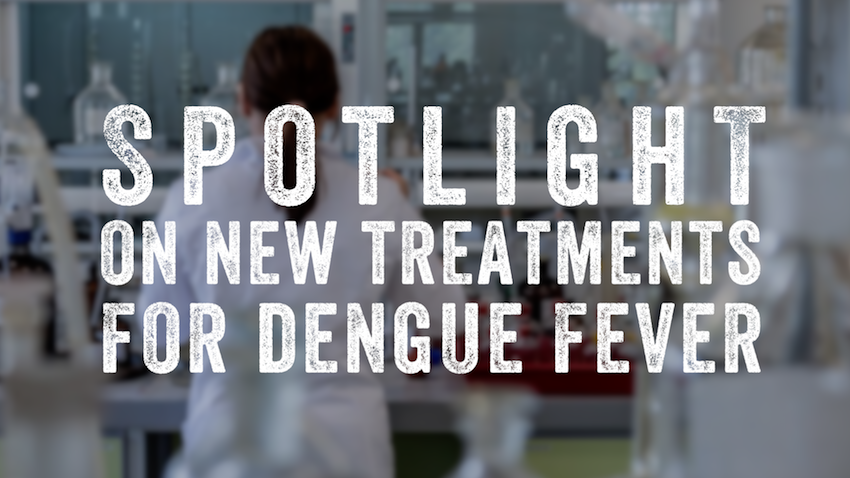- by Alison
Spotlight on new treatments for dengue

We’ve talked a lot recently about the dengue vaccine, but treatments for dengue have also been making significant progress over recent years. Let’s take a brief look at three treatments for dengue, each at a different stage of development.
NGI-1: inhibiting access to resources
Researchers at the Stanford University School of Medicine are in the midst of developing a novel treatment for dengue that could potentially also work against other flaviviruses – a family of viruses that includes the West Nile virus, yellow fever, and Zika as well as dengue.
According to a report published on the school’s website, “The approach, rather than killing the viruses directly, is akin to cutting off a crime family’s bank accounts. It revolves around inhibiting access to a complex of proteins in mammalian cells on which the viruses rely when they invade.”
So, how does it do that?
Simply put, the treatment stops the body’s cells feeding sugars to the proteins that the virus relies on to multiply and invade the body. When researchers grew cells that didn’t have this mechanism, they found the virus was unable to multiply in those cells.
After this discovery, the Stanford team teamed up with another group of researchers, this time from Yale School of Medicine. The Yale team had developed a drug, NGI-1, that blocks this mechanism in human cells.
The researchers saw a 99 percent decrease in infection when they treated dengue-infected cells with NGI-1 immediately after initial infection and an 80 percent decrease when they administered the treatment after 24 hours, according to an article in Medical Xpress. The article also reveals that the researchers have shown that the treatment could potentially treat “all four dengue types and multiple strains of Zika, as well as against West Nile and yellow fever virus.”
The newsfeed on Yale’s website reports, “The research team found that while NGI-1 restricted viral activity, it did not affect other cell functions, which suggests a low risk of toxicity or side effects.”
Next steps focus on improving the treatment further and extending testing.
VIS513: lowering viremia levels
US-based Visterra has identified an antibody that can neutralize all four dengue serotypes. The company hopes VIS513, as this treatment for dengue is known, will not only reduce the levels of virus in circulation but also prevent severe dengue and reduce platelet loss.
VIS513 is a monoclonal antibody, which means it can recognize and find a specific protein on the virus. Simplifying an explanation in Science Direct, Visterra believes the antibody will reduce the amount of virus circulating in the blood – or levels of viremia if you want to get technical – by binding to one of the virus’ proteins.
Researchers have found that people with severe dengue have high levels of the virus circulating in their blood in the early stages of the illness than those with uncomplicated dengue. Visterra, therefore, believes “lowering viremia in the early phase of illness could reduce the risk of severe dengue”, and pre-clinical trials have shown the candidate drug does protect animals against the virus.
Visterra is developing VIS513 further in collaboration with the Serum Institute of India Private Limited. SIIPL is expected to initiate clinical trials later this year and then manufacture, obtain regulatory approval for and commercialize VIS513 around the world, except for in North America and the EU.
If all goes well, we could potentially see this treatment for dengue entering clinics in 2018.
GBV006: combining therapies
Globavir Biosciences, Inc. has created a proprietary compound by combining two oral drugs that are already approved. A Globavir corporate presentation reveals that GBV006 combines GBV001 and GV002, two drugs that have been shown to be very effective in treating Chikungunya. Like NGI-1, GBV006 targets processes in the body’s cells.
According to PR Newswire, the compound is “based on research carried out at Stanford University School of Medicine.”
While there is little information on how the compound works or its components work, the corporate presentation does show that early clinical trials planned for Q2 2018 will test how safe and how tolerable the drug is, while taking an early look at how well it works. Trials planned for Q2 2019 will establish how well it works; a blind trial will compare the drug against a placebo. The next step, after these evaluations, will be gaining approval in Singapore.
We hope you found this taster of the many treatments for dengue currently under development around the world today interesting. We’d love to hear about any novel treatments for dengue you might be aware of.

